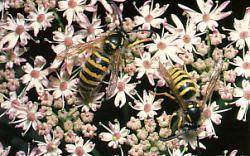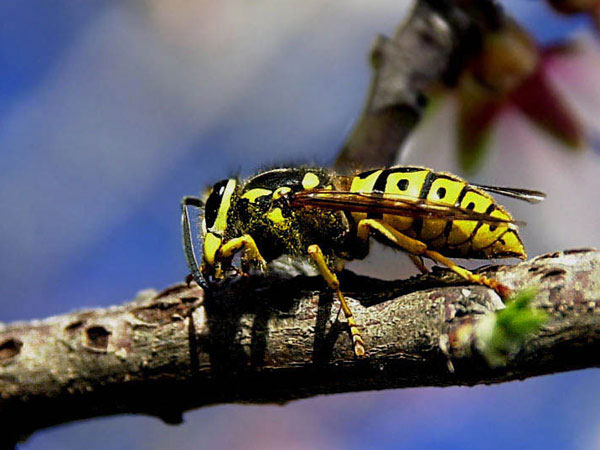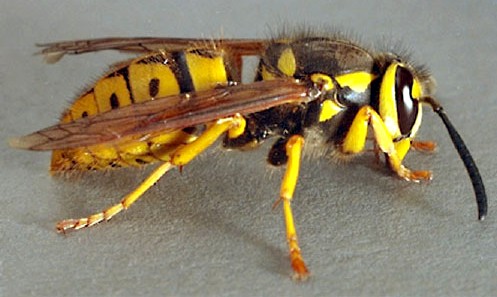|
|
YELLOW JACKET or WASP |
|
Wasps are beneficial insects. They are natural scavengers who eat other, pesty insects such as flies and caterpillars. They help by limiting (eating) the number of pest insects that bother people. Some wasps also pollinate plants and crops. It is important that wasps be left alone if they are not bothering you, because they have a painful sting. AND, they can sting you more than once. Yellow Jackets are also scavengers. They hunt for food where ever they can find it. Wasps and Yellow Jackets often fly around when people are eating outside because they are looking for food. There are seventeen species of wasps in North America. The species that people see most is the Western Yellow Jacket. Yellow jackets are beneficial because they are pollinators and every day they eat lots of pest insects like harmful caterpillars and flies. Adult wasps are 1/2 to 3/4 inch long, with yellow and black stripes and transparent wings. Most people are afraid of Yellow Jackets because of their sting. The sting of a Yellow Jacket is very painful and can kill people who are allergic. Because of their sting, people remove Yellow Jacket nests and use poisons to kill them. However, nests should not be removed if the wasps are not interfering with the lives of people in the area - because the are beneficial to humans and the environment. Most people know what the yellow jackets look like. They are wasps with black and yellow markings on the head, thorax and abdomen. The Western Yellow Jacket is found throughout Canada and the United States, and south into Mexico. In most of North America, yellow jacket colonies are seen in the warmer months, but they die in the winter. Yellow jackets build their nests either in the ground or attached to branches of bushes or trees., sometimes you can find nests attached to buildings. People also find them under porches and steps and in the cracks of sidewalks. The Western Yellow Jacket likes to nest on the ground.
Yellow Jackets are social
wasps who live in colonies that contain workers, queens and males. Colonies only
last for one year. The males and worker bees die every winter, but the queen
lives on. Fertilized queens spend the winter in
protected places like hollow logs, stumps, under bark, in leaf litter, in soil
cavities and human-made structures. Queens come out of their winter hiding
places when the weather gets warmer (from late
February to early April). Then they select a nest site and build a small paper nest in
which they lay eggs. After the eggs hatch, the queen
feeds the young for about 18 to 20 days. The young (called Larvae) emerge later
from the nest as
small, infertile female wasps called workers.. Yellow Jackets are drawn to people who are eating or drinking sweet foods outside. This is especially true in the fall when the yellow jackets are most aggressive. They are also drawn to people who wear perfumes or cologne, because they are attracted to anything that smells like flowers. The also like to fly around people who are wearing brightly colored clothing, especially clothing with flower patterns. Remember, when you see a wasp or yellow jacket, don't panic or try to kill it. These are beneficial bugs because they are pollinators and they feed on a lot of soft-bodied insects such as caterpillars and flies that are harmful.
|



